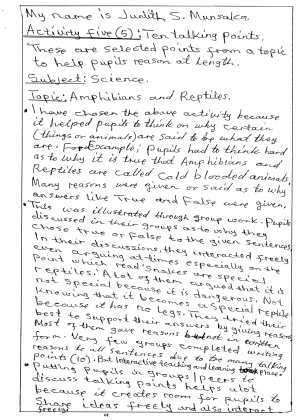Video/Judith portfolio recording - talking points.mp3
Series: Judith - talking pointsThe wikipage input value is empty (e.g. <code>SomeProperty::, [[]]</code>) and therefore it cannot be used as a name or as part of a query condition.
[[|<<<]] [[|>>>]]
AUDIO
Judith portfolio recording - talking points.mp3
The description of the video
Judith portfolio recording - talking points.mp3, 1:23,(Series: Judith - talking points, episode N/A)
Embed code
To use this video, you can simply cut and paste this text into a new wiki page:
{{: Video/Judith portfolio recording - talking points.mp3 }}
This video is used on the following pages
Video/Judith portfolio recording - talking points.mp3
Background on this video
Background on this video is available here:
![]() Observing, thinking, reflecting (15 min): Listening to a Zambian teacher's audio reflection on a talking points activity followed by individual work on portfolios.
We now listen to a clip that was recorded after the teacher (Judith) had use talking points with her lesson. She is reflecting on the talking points activity and recording her own thoughts about how the pupils responded to the activity. Notice how she uses a specific example and records what the pupils said. She reflects on how successful (or otherwise) her planning was and concludes that there were too many talking points for the pupils to get through in the time allowed.
Observing, thinking, reflecting (15 min): Listening to a Zambian teacher's audio reflection on a talking points activity followed by individual work on portfolios.
We now listen to a clip that was recorded after the teacher (Judith) had use talking points with her lesson. She is reflecting on the talking points activity and recording her own thoughts about how the pupils responded to the activity. Notice how she uses a specific example and records what the pupils said. She reflects on how successful (or otherwise) her planning was and concludes that there were too many talking points for the pupils to get through in the time allowed.
“Very few groups completed writing reasons to all sentences due to too many talking points but interactive teaching and learning took place.”
Questions for reflection
Questions for reflection are available here:
The image here shows a copy of Judith's portfolio submission for this activity. In this case she has written her reflection and then recorded herself reading it. It is not necessary to present two versions of your reflections, one or other would be fine. How are your portfolios's coming on? Ask yourself the following questions:
- When you reflected on the talking points activity did you record the subject and topic of the lesson?
- Did you comment on how the pupils specifically/personally responded to the talking points?
- Where there any unexpected points made by the pupils?
- Did your talking points spark a discussion between pupils (as it did in Judith's case with the snake)? If so, what was is?
- What evidence do you have that interactive teaching and learning took place? This will most likely come from the conversations that took place between the pupils so you should record this in your reflection.
- What adjustments will you make when you do the talking points activity again?
Use the remaining time now to work on your portfolios, making sure that your reflections are meaningful and in enough depth with enough detail. You should include at least one portfolio entry based on an aspect of group work. Work with a partner if you would find it useful to have their feedback on what you have written. Use Judith's portfolio entry as a useful example to follow if you are unsure about how much to write.
Transcript
A transcript is available here:
My Name is Judith S Munsaka. Activity five (5): Ten talking points. These are selected points from a topic to help pupils reason at length:
- Subject: Science
- Topic : Amphibians and reptiles
I have chosen the above activity because it helped pupils to think on why certain (things or animals) are said to be what they are. For example; pupils had to think hard as to why it is true that Amphibians and reptiles are called cold blooded animals. Many reasons where given as to why, answers like True and False were given. This was illustrated through group work. Pupils discussed in their groups as to why they chose true or false to the given sentences. In their discussions they interacted freely, even arguing at times especially on the point which read 'snakes are special reptiles'. A lot of them argued that it is not special because it is dangerous. Not knowing that it becomes a special reptile because it has no legs. They tried their best to support their answers by giving reasons. Most of them gave reasons but not in written form. Very few groups completed writing reasons to all sentences due to too many talking points (10). But interactive teaching and learning took place. Putting pupils in groups/peers to discuss talking points helps a lot because it creates room for pupils to share ideas freely and also interact freely.

